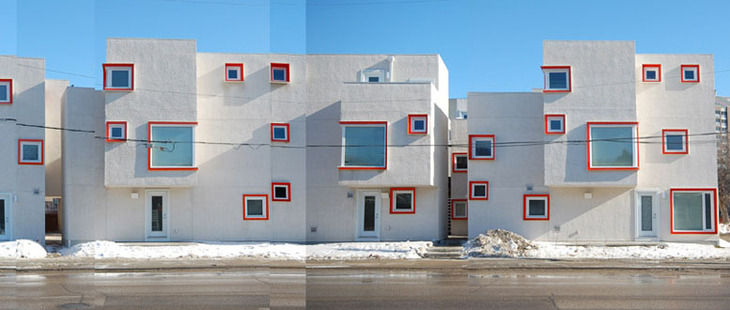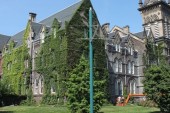
 Courtyard House by Studio Junction.
Courtyard House by Studio Junction.
Back in 1956, the City of Toronto opened itself up to the world of architecture. An open competition for a new city hall got 510 entries from 42 countries, and we all remember the winner: Viljo Revell’s famous curved towers, which became an icon of the city.
But if you look back at the shortlist, Revell’s isn’t the only interesting name. There’s I.M. Pei, a star in the making, long before he designed Commerce Court here. Then there is a group of Harvard students including John Andrews and Macy DuBois. Those two moved here, rooted themselves in the city, and built important buildings like Scarborough College… and the CN Tower. That competition didn’t just build City Hall. It helped build the city’s design culture.
But that’s history. When was the last time Toronto took a chance? How often do young designers get hired for public projects, or big ones? In other words, where are you going to find tomorrow’s John Andrews?
This is where 20 + Change comes in. A biannual show of work from “emerging” designers, across Canada, it’s now running at Harbourfront Centre’s architecture gallery, and co-curator Heather Dubbeldam says it’s designed to fill just that same need. “There aren’t many public forums for emerging firms in Canada,” says Dubbeldam, who heads the Toronto Society of Architects. “Most young firms, when they start out, are doing houses—and those aren’t public. We figured that there is a need to help promote these young practices.”
The show, which continues to Nov. 9 at York Quay Centre, includes some designers who are doing private houses, and very well. There’s Atelier Kastelic Buffey, who have managed to find clients with the budgets and the appetite for adventurous country houses; nkArchitect, a very young firm who’ve designed a beautifully tailored house in the Annex (and sleek, frosty interiors for the Nadege patisseries); and _naturehumaine, who have designed a couple of remarkably mature and beautiful houses in Montreal.
 Centre Village, a Winnipeg housing co-op designed by 5468796 Architecture Inc.
Centre Village, a Winnipeg housing co-op designed by 5468796 Architecture Inc.
But other designers are showing they’re ready to tackle bigger problems—and they’re doing it. “Many of these firms have moved to self-inititated projects,” Dubbeldam says. “Like 5468796, who have been studying distressed sites and proposing solutions to developers.” Those numbers are the name (unfortunately) of 5468796 Architecture Inc., a Winnipeg office that’s pushed their own agenda to revitalize downtown Winnipeg. The result in one case is Centre Village, a co-op built on a cheap budget that is gorgeous, inventively formed and street-friendly.
There’s yet another model, too, of architects who work for themselves. There is Studio Junction, whose Courtyard House, a home and office that they built off a rough stretch of Davenport, is a marvel of handcraft and brilliantly planned space. I covered it (enthusiastically) for the prestigious design magazine Dwell, and in Dubbeldam’s eyes, it is major work: “They have created a new housing typology for North America,” she says approvingly.
 Courtyard House by Studio Junction.
Courtyard House by Studio Junction.
As that comment suggests, this show is driven by a collegial spirit. Dubbeldam herself is a very good architect who heads an “emerging” practice of her own—she was in the first Twenty + Change, before she took over running the program. Having appeared in Wallpaper magazine and been honoured with a national Canadian award, her office is still working on relatively small projects.
Same goes for her co-curator Lola Sheppard, who takes a more theoretical bent with her Lateral Office. They just won a $100,000 prize from the Holcim Foundation for a food-distribution network for Canada’s high Arctic.
But in Canada, certainly in Toronto, good architects like this don’t get hired for big buildings, or parks, or other public projects. “Emerging” designers—and in architecture, they can have two decades of design experience—often seem too risky to our public institutions and builders. “Clients want the firms with experience,” Dubbeldam says. “They want the tried and true, and you can’t blame them. But there are lots of competitions where you need to have done five or more similar projects just to qualify. And how do you get those five? Or that first one?”
Case in point: the recent competition for the St. Lawrence Market North Building, which was won by Richard Rogers with Adamson Associates. The winning design is great. A couple of the others are very good. But the list definitely doesn’t reflect the full range of talented designers in this city, never mind the country or the world. And why not?
 Nadge Patisserie on Queen St. West by nkArchitect
Nadge Patisserie on Queen St. West by nkArchitect
It’s a cultural problem, and one challenge is just making the young upstarts visible. Other countries have governments or foundations that make this an issue. In the U.S., there is the Young Architects’ League; in the Netherlands, the Maastricht Prize; and in the Czech Republic, the Young Architects’ Award. We have a museum show curated by generous volunteers.
Happily, it has a home at Harbourfront. For about a year now, Harbourfront has had a gallery purely devoted to architecture. While the 20 + Change show occupies a temporary gallery, the main Architecture Gallery has a show called “Too Tall?” It’s a provocative question in Toronto, and thanks to curator Patrick Macaulay this show moves the conversation along a bit. The architects—KPMB, architectsAlliance, and RAW Design—each bring a serious commitment to good city-building and thoughtful architecture. And in this case they each produce some useful arguments for Toronto along with showcasing their own work in a way that feels a bit like self-promotion.
On Wednesday, Nov. 2, some of their big minds will hash out questions about what a more vertical Toronto should look like, and how well a tower-filled city can work. The discussion includes Peter Clewes of architectsAlliance, Bruce Kuwabara of KPMB, and Richard Witt of RAW. These are some of the country’s leading architectural lights, and if another City Hall comes along tomorrow, they’ll be likely to wind up on the shortlist. Go and listen to them. And then look at the gallery next door to see who might be joining them. In a decade or two, perhaps.
__
Alex Bozikovic writes frequently on architecture for Toronto Standard.














